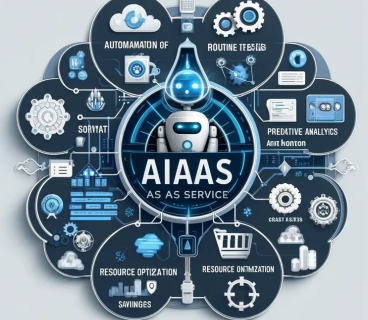Over the past few months, I have been researching how to apply AI technology to our #mygov product and what nuances to pay attention to in this process. First, I realized that AI is not just a technology, but also a strategic transformation tool. Companies are moving away from focusing only on specific software use cases and are trying to build secure and scalable platforms that support agile innovation. Since mygov is a citizen-oriented product, it is important for us to tread carefully when implementing AI. We need to create individual approaches, taking into account not only normative principles, but also the business context. The next most important question I asked myself is: Is AI Governance important for us?
What is AI Governance?
Artificial Intelligence (AI) governance is a set of rules, standards and control mechanisms established to ensure that AI systems operate safely, ethically and responsibly. This approach aims to address potential risks associated with AI while ensuring that it delivers positive benefits to society.
The main goal of AI governance is to ensure fairness, security and respect for human rights in the development and application of AI. This framework encourages innovation while implementing effective controls to minimize risks such as bias, privacy breaches and abuse. AI governance is not just about technical aspects; it also includes ensuring that AI is consistent with ethical and social values.
Key Components of Artificial Intelligence (AI) Governance. The following key elements are in focus within the AI governance framework:
Ethical Approach: Ensuring that AI systems operate in accordance with society’s values requires the joint participation of various stakeholders, such as policymakers, ethicists, developers and users. This approach provides an inclusive and comprehensive perspective to address AI-related issues.
Risk Mitigation: AI systems are vulnerable to human bias and error because they are built by humans. Flawed algorithms and inaccurate data sets can lead to bias, incorrect decisions, and other harmful outcomes. Governance provides a structured approach to mitigate these risks.
Regulation and Policy: AI governance requires machine learning algorithms to be monitored, evaluated, and updated. At the same time, appropriate rules are implemented to ensure that data sets are accurately and correctly trained.
Responsible Governance: AI governance is equipped with control mechanisms that ensure that its behavior is aligned with ethical standards and public expectations.
The Importance of AI Governance
AI governance not only improves the technical performance of AI systems, but also ensures that their social and economic impacts are directed in a positive direction.
Effective Governance:
- Encourages innovation and builds trust.
- Prevents bias and ethical issues.
- Protects human rights and ensures privacy.
Why is AI Governance Important?
Artificial intelligence (AI) governance plays a critical role in ensuring compliance, trust, and efficiency in the development and implementation of technology. As AI is increasingly integrated into organizational and government operations, the potential for negative impacts of this technology is becoming more apparent. AI governance is an important approach to ensuring that technology impacts society in a safe and ethical manner.
The Need for AI Governance
To understand the potential risks and negative impacts of AI, it is enough to look at some past incidents:
The Thai Chatbot Incident: Microsoft’s AI chatbot named Tay learned toxic behaviors from social interactions on social media.
COMPAS Program: The COMPAS tool used in the United States led to unfair outcomes by making biased judgment decisions. This example highlights how AI systems can create bias through misdirected data sets.
Deepfake Technology Abuse (2019). Deepfake technology has been used to create fake videos using the faces and voices of celebrities. The technology has caused great concern, especially when it has been used for political manipulation and damage to personal reputations. Such applications of AI have shown that it can be used to undermine public trust and spread misinformation.
Tesla Autopilot Accidents (2016 and 2018). Tesla cars driven in Autopilot mode have caused various accidents. In some cases, the AI-based systems failed to correctly recognize road signs or other vehicles. These incidents, such as
The risks to which AI is susceptible have shown that they can have serious consequences, especially in areas directly related to human life.
Transparency and Accountability
One of the key principles of AI governance is transparency. Understanding how AI systems make decisions is essential to holding them accountable and maintaining public trust. AI plays a role in a wide range of decisions, from selecting advertisements to approving loans. Ensuring that these decisions are ethical and fair is critical for both users and organizations.
Long-Term Maintenance of Ethical Standards
AI governance is not just about ensuring that the technology is compliant once, but also aims to maintain ethical standards over time. AI models can lose their accuracy and reliability over time, a process called “model drift.” For this reason, governance frameworks require models to be continuously monitored and updated.
Social Responsibility and Sustainable Development of Technology
AI governance goes beyond legal compliance and plays a key role in ensuring the social responsibility of AI. This approach supports the responsible growth of technology while protecting against financial, legal and reputational harm.
Examples of AI Governance
AI governance encompasses a range of policies, frameworks and practices to ensure the responsible, ethical and secure development and deployment of AI technologies. Some examples of AI governance in real-world applications include:
General Data Protection Regulation (GDPR). The European Union’s GDPR regulations are an example of AI governance in relation to personal data protection and privacy. Although the GDPR is not specifically aimed at AI, it has significant implications for AI systems. These regulations require transparency, user consent and data protection, particularly when processing personal data. GDPR requirements help ensure that AI systems are used ethically and responsibly.
For example: GDPR gives users the right to understand how decisions are made when AI algorithms make automated decisions and helps ensure that these decisions are fair.
Organisation for Economic Co-operation and Development (OECD) Principles. The OECD Principles on Artificial Intelligence are implemented in over 40 countries and emphasize the responsible governance of trusted AI. These principles aim to ensure that AI systems are transparent, fair and accountable. At the same time, they are designed to protect human rights and ensure that AI contributes to social well-being.
For example: The OECD Principles require that AI systems have appropriate safeguards in place to protect people from harm.
Corporate AI Ethics Committees. Many large companies have established ethics boards and committees to oversee AI initiatives. These boards ensure that AI products and services are consistent with ethical principles and public values.
- IBM: IBM has established an AI Ethics Council to ensure that AI products and services comply with the company’s AI principles. The council reviews AI projects from legal, technical, and ethical perspectives.
- Google: Google has also adopted AI principles that govern AI research and applications, and has formed an internal ethics committee to enforce these principles.
China’s Social Credit System. China’s social credit system uses AI governance to evaluate citizens’ behavior using public data. Although this system is controversial, it does have governance controls in place.
Twitter’s Algorithmic Transparency Initiative. Twitter is implementing specific regulatory principles to increase transparency in its algorithms. This will give users more information about the content they choose to use on the platform.
These examples show that AI governance is being widely used in the real world across a variety of industries and sectors to build public trust, prevent bias, and ensure ethical standards are maintained.
AI Guidelines by Regulatory Bodies. Some countries are developing regulatory bodies and guidelines to ensure AI governance. For example:
- USA: The National AI Initiative ensures the protection of safety and ethical principles in the development of artificial intelligence.
- European Union: The AI Guidelines aim to promote the ethical use of artificial intelligence and reduce its harmful effects.
- Azerbaijan: The Artificial Intelligence Strategy and the Digital Code, which are being prepared in our country by the Innovation and Digital Development Agency, are documents of great importance in this field. Special sections are allocated to artificial intelligence (AI) technologies in the RM. The aim of the artificial intelligence strategy is to ensure the ethical use of this technology in our country. is to ensure that AI is developed safely and responsibly. The Digital Code, on the other hand, creates a legal framework for the application of AI, reflecting important regulations for the technology to be beneficial to society. These initiatives will significantly contribute to Azerbaijan taking a leading position on the path of digital transformation and becoming a regional leader in the field of AI.
Data Governance. An important aspect of AI governance is data governance. Providing high-quality data sets is vital for AI systems to make unbiased and accurate decisions. For example, many organizations adopt standards to ensure data diversity and objectivity.
Transparency and Explanation Mechanisms. A practical example of AI governance can be the rules that companies apply to ensure that the algorithms used work in a transparent and explainable manner. This allows users to understand and trust the decisions of AI systems.












